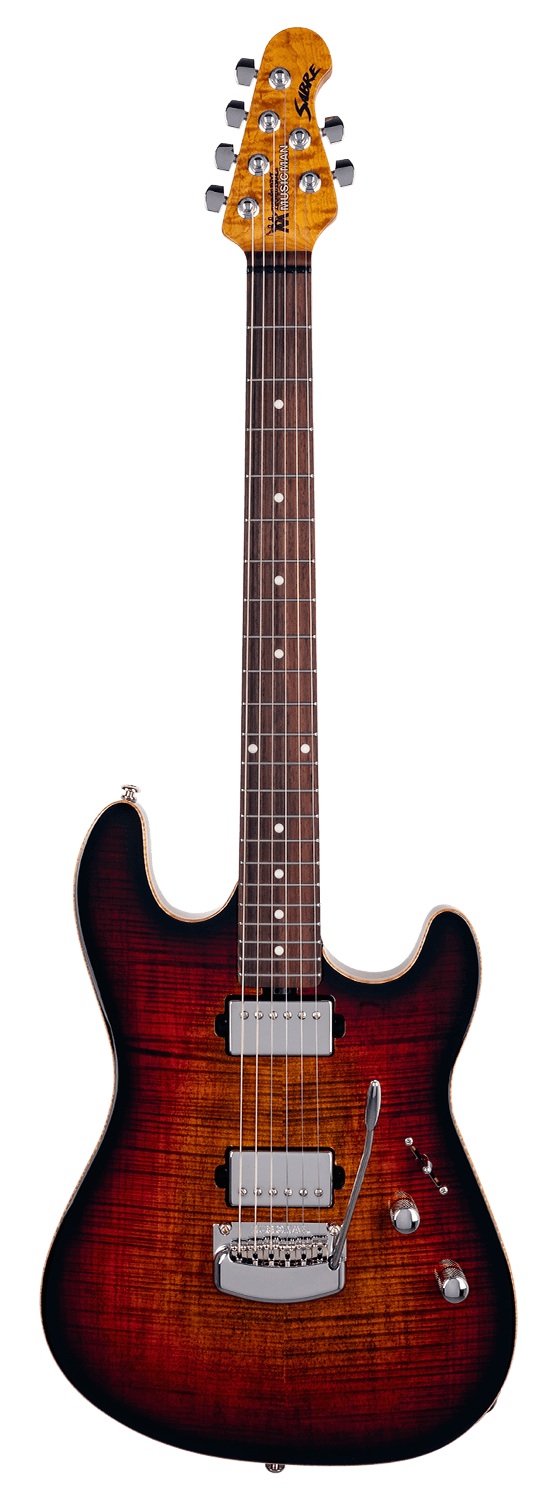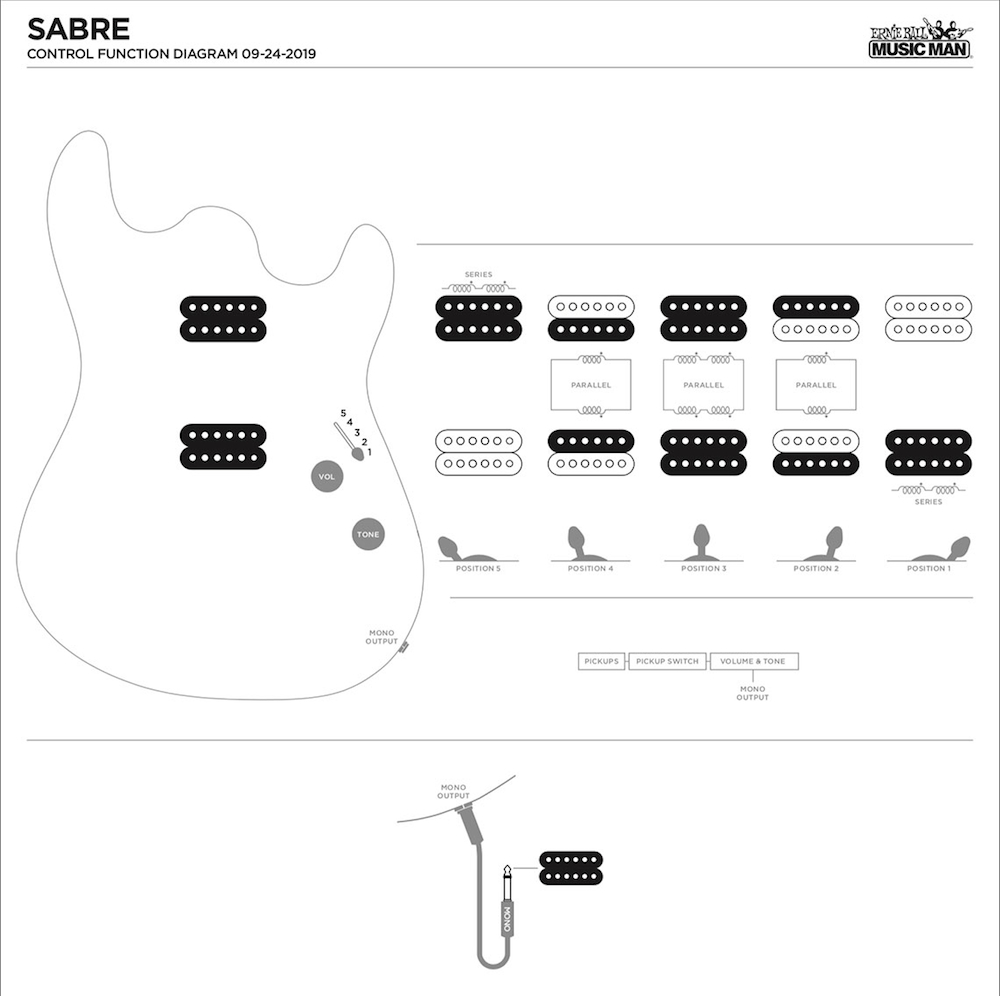New Gear Review: Sabre Electric Guitar by Ernie Ball Music Man

Ernie Ball Music Man continues to bring to the market top-tier musical instruments—can their Sabre electric guitar be the next addition to your collection?
A prominent force in the industry since its emergence in the early ‘70s, Music Man guitars and basses are still among the most respected, high-end musical instruments on the market.
Originally started by Forrest White, Tom Walker, and industry legend Leo Fender (as a silent partner), the Music Man brand was acquired by Ernie Ball in 1984. Offering top-notch guitars, basses, strings, and accessories, the family-owned business promptly became a staple in the ever-expanding electric guitar landscape.
Early endorsements from renowned players like Eddie Van Halen, Steve Morse, Albert Lee, Steve Lukather, and John Petrucci, to name a few, certainly helped the manufacturer’s initial growth. Nowadays, guitarists such as Annie Clark (St. Vincent), Jason Richardson (All That Remains), and James Valentine (Maroon 5), among many others, proudly display their artist series Music Man models on stage, upholding the California company’s reputation of excellence.
Alongside the lines of artist-approved instruments, Ernie Ball Music Man continues to design and produce new and notable guitars and basses for any player in search of first-rate craftsmanship.
The company has graciously sent me their latest model Sabre (in Bougie Burst) for close inspection and review here on SonicScoop. Let’s see if this instrument upholds Music Man’s reputation as one of the most sophisticated builders of guitars today.
Features
The Sabre is a solid body six-string electric guitar. It’s available in four distinct finishes: Deep Blueburst, Cobra, Honey Suckle, and Bougie Burst. The double-cutaway, contoured body is made from okoumé, an African hardwood found in the Congo, Gabon, and Guinea. It’s adorned with an exquisite 3/8” flamed maple top—extending to its natural binding—and figured roasted maple neck, which has a slim C profile and a 1-11/16″ nut width.
The fingerboard material, depending on your original color choice, is ebony, maple, or rosewood. The fingerboard inlays are available in white (for Deep Blueburst and Bougie Burst) or black (for Cobra and Honey Suckle). The neck finish is comprised of gunstock oil and a hand-rubbed special wax blend.
Most of the guitars are equipped with chrome hardware, except for Cobra, which comes in matte black.
The vast majority of other features are the same across the board. These include 22 medium stainless steel frets, a 25.5” scale length, Schaller M6-IND locking tuners, a melamine nut, the Ernie Ball Music Man tremolo system with crescent cover and vintage bent steel saddles, two proprietary custom-wound humbucking pickups, one volume knob, one tone knob, and a five-way pickup switch.
As always, this guitar is fitted with the company’s unique 4-over-2 straight string pull design, eliminating the need for a string tree on the headstock. And, of course, Ernie Ball Slinky strings (.010 – .046) arrive factory-equipped on every guitar.
In Use
The Sabre came packaged in a sturdy hardshell case. Upon opening the case, the guitar’s overall design struck me as truly impeccable. Whether practicing speedy licks, scale sequences, or strumming chords, I found that the Sabre offered exceptional playability. It’s comfortable, ultra-smooth, and provided sustain for days. Moving up and down the neck felt effortless.
All-around ergonomic, the body shape fit snuggly while playing seated. When standing, the guitar didn’t falter or feel burdensome. The Sabre had a generous span of tonal variety depending on pickup selection. In many ways, it screamed dynamic modern rock to me, but it wasn’t at all back-breaking to dial in bluesy crunch or polished pop tones as well.
The five-way pickup switch came across as robust and secure no matter its position. It offered a nice mixture of options depending on its placement. You can choose between the usual bridge pickup (in position 1), both pickups (in position 3), and neck pickup (in position 5). The best part is the ability to split the pickups in positions 2 and 4. In position 2, you engage the outside coils, whereas in position 4, you engage the inside coils—achieving more of a Strat-style sound.
The volume knob had a wonderfully tight and weighted feel. The tone knob had less tension in comparison, but it still felt solid. Having been hand-soldered in the company’s San Luis Obispo factory, all of the guitar’s electronics appear nothing but durable.
The Schaller M6-IND locking tuners were very reliable. The guitar’s tremolo system is strong and hardy. I had no issues staying in tune after bending an exorbitant amount.
Let’s hear what this guitar can sound like in action…
Producer extraordinaire Butch Walker diggin’ in and driving the Sabre:

Guitarist Chance Taylor demonstrating the Sabre’s pristine tone:

Sadler Vaden showing off some crunchy melodic goodness:

To Be Critical
If you’re already familiar with Ernie Ball Music Man, you know that their instruments are by no means cheap. Depending on the design and artist affiliation, prices can get steep, even exceeding $5,000. Their new Sabre model is currently available in the median range for $3,200. For most of us, this instrument is a major investment, and though not a critique on its design, it is up to you whether the Sabre’s rather hefty price tag is justified by your individual needs and demands.
A little research on this model led me to find a few Music Man Sabre I and Sabre II guitars from the late ‘70s available for sale online. Famously used on Third Eye Blind’s eponymous debut, these guitars only share a couple of similar characteristics to the model in this review. However, if the price point for a new model is too high—and a Sterling by Music Man version isn’t released any time soon—those vintage options could be worth a look.
Summing it Up
It’s difficult not to praise Ernie Ball for producing another superbly versatile electric guitar. In one word, this new model is outstanding. With that said, it really is doing a disservice to describe any instrument with a single adjective, isn’t it?
So, allow me to put it this way: Sabre delivers a much sought-after balance of precision, definition, and fullness in a custom shop-quality package. Visit your local guitar shop and give it a whirl—you won’t be disappointed.
Michael Duncan is a record producer, engineer, and writer who lives in NYC.
Please note: When you buy products through links on this page, we may earn an affiliate commission.








[…] Originally started by Forrest White, Tom Walker, and industry legend Leo Fender (as a silent partner), the Music Man brand Read more… […]